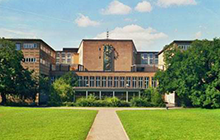SAT数学常识讲解:多边形.
2017-08-06 280阅读
A polygon is a two-dimensional figure with three or more straight sides. (So triangles are actually a type of polygon.) Polygons are named according to the number of sides they have.
All polygons, no matter how many sides they possess, share certain characteristics:
Since ABD is an equilateral triangle, the length of each side of the rhombus must be 4, and angles ADB and ABD are 60º. All you have to do is find the height of the rhombus. Draw an altitude from A to DC to create a 30-60-90 triangle.
Since the hypotenuse of the 30-60-90 triangle is 4, you can use the ratio 1::2 to calculate that the length of this altitude is 2. The area formula for a rhombus is bh, so the area of this rhombus is 4 2 = 8.
Square
A square combines the special features of the rectangle and rhombus: All its angles are 90º, and all four of its sides are equal in length.
The square has two more crucial special qualities. In a square,
- The sum of the interior angles of a polygon with n sides is (n – 2). For instance, the sum of the interior angles of an octagon is (8 – 2) = 6 = .
- The sum of the exterior angles of any polygon is .
- The perimeter of a polygon is the sum of the lengths of its sides. The perimeter of the hexagon below is 5 + 4 + 3 + 8 + 6 + 9 = 35.
- Opposite sides are equal in length: BC = AD and AB = DC
- Opposite angles are equal: and
- Adjacent angles are supplementary:
- The diagonals bisect (split) each other: BE = ED and AE = EC
- One diagonal splits a parallelogram into two congruent triangles:
- Two diagonals split a parallelogram into two pairs of congruent triangles: and
- All four sides are equal: AD = DC = CB = BA
- The diagonals bisect each other and form perpendicular lines (but note that the diagonals are not equal in length)
- The diagonals bisect the vertex angles
|
|||||||||
- Diagonals bisect each other at right angles and are equal in length.
- Diagonals bisect the vertex angles to create 45º angles. (This means that one diagonal will cut the square into two 45-45-90 triangles, while two diagonals break the square into four 45-45-90 triangles.)
- The sum of the interior angles of a polygon with n sides is (n – 2). For instance, the sum of the interior angles of an octagon is (8 – 2) = 6 = .
- The sum of the exterior angles of any polygon is .
- The perimeter of a polygon is the sum of the lengths of its sides. The perimeter of the hexagon below is 5 + 4 + 3 + 8 + 6 + 9 = 35.
- Opposite sides are equal in length: BC = AD and AB = DC
- Opposite angles are equal: and
- Adjacent angles are supplementary:
- The diagonals bisect (split) each other: BE = ED and AE = EC
- One diagonal splits a parallelogram into two congruent triangles:
- Two diagonals split a parallelogram into two pairs of congruent triangles: and
共2页
阅读全文留学咨询
更多出国留学最新动态,敬请关注澳际教育手机端网站,并可拨打咨询热线:400-601-0022
留学热搜
相关推荐
- 专家推荐
- 成功案例
- 博文推荐

Copyright 2000 - 2020 北京澳际教育咨询有限公司
www.aoji.cn All Rights Reserved | 京ICP证050284号
总部地址:北京市东城区 灯市口大街33号 国中商业大厦2-3层









高国强 向我咨询
行业年龄 11年
成功案例 2937人
留学关乎到一个家庭的期望以及一个学生的未来,作为一名留学规划导师,我一直坚信最基本且最重要的品质是认真负责的态度。基于对学生和家长认真负责的原则,结合丰富的申请经验,更有效地帮助学生清晰未来发展方向,顺利进入理想院校。
Tara 向我咨询
行业年龄 6年
成功案例 1602人
Cindy 向我咨询
行业年龄 18年
成功案例 4806人
精通各类升学,转学,墨尔本的公立私立初高中,小学,高中升大学的申请流程及入学要求。本科升学研究生,转如入其他学校等服务。
薛占秋 向我咨询
行业年龄 10年
成功案例 1869人
从业3年来成功协助数百同学拿到英、美、加、澳等各国学习签证,递签成功率90%以上,大大超过同业平均水平。